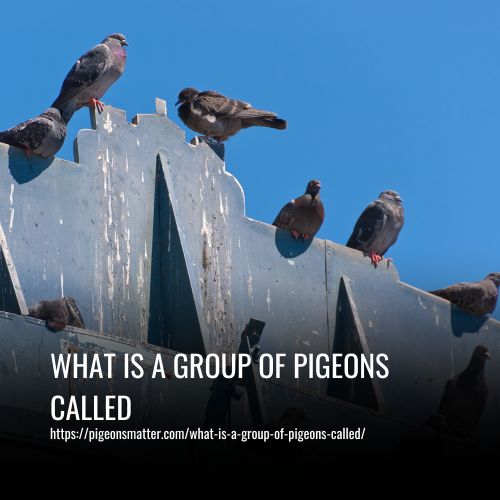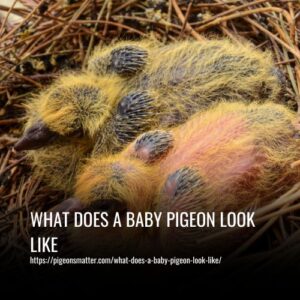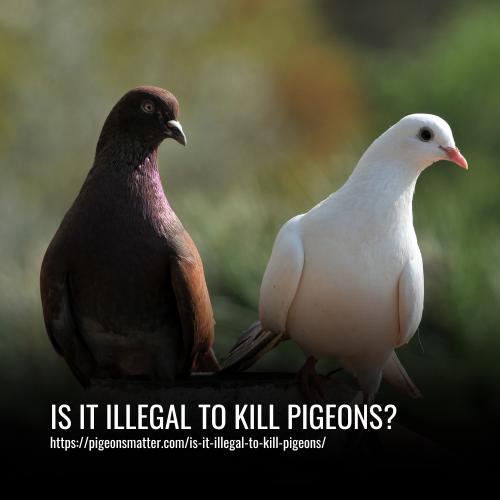Common names for a group of pigeons are a flock of pigeons, a flight of pigeons, and a kit of pigeons. These names are widely recognized and used to refer to a group of these birds. Additionally, there are some less common names such as a passel, a stool, a plague, a school, and a loft of pigeons. These names are not as widely known but can still be used to describe a group of pigeons. Baby pigeons are commonly referred to as squabs.

Do Pigeons Flock Together In Groups
Pigeons are social birds that tend to flock together in groups, both large and small. In urban areas, feral pigeons have the ability to create large colonies and typically feed and roost together in any available space. Pigeons tend to gather in flocks outside of their breeding season, while they form pairs to nest and care for their young during that period. In the winter, pigeons tend to roost communally in protected areas such as forests, buildings, or other high-up spots.
While some species of pigeon may stick to small flocks or remain in mated pairs for most of the year, pigeons are generally highly social creatures that prefer to flock together rather than stay isolated.
How Many Pigeons Are In A Flock
Flock sizes of pigeons and doves can vary greatly depending on the species. For common species like wood pigeons, feral pigeons, and rock doves, flocks can range from just a few birds to groups of hundreds or even thousands. These birds have a natural tendency to collect in large numbers, especially in urban and rural areas where food and nesting sites are abundant.
Why Do Pigeons Flock Together
Pigeons flock together for various reasons, including protection against predators and traveling. When pigeons flock together, they gain strength in numbers, which helps protect them from predators both on the ground and in the air. Pigeon flocks also provide selfless protection from flying predators like hawks, as they behave collectively to reduce the odds of any single pigeon from being caught.
Many species of pigeons and doves travel in flocks rather than alone or in pairs, and this behavior is often observed during long-distance flights. Some species of pigeons, such as wood pigeons in Europe and Nicobar pigeons, are known to travel significant distances between their food sources or habitats. Pigeon flocks utilize a hierarchical structure that allows for the rotation of leadership during flight.
When Do Pigeons Flock Together
Pigeons are social birds that typically depend on their flock for the majority of the year. They tend to gather in flocks of varying sizes, often congregating in areas with plentiful food sources. In the winter months, pigeons will roost together for warmth and protection against predators
During the breeding season, pigeons exhibit solitary behavior as they construct nests and care for their young. However, for the majority of the year, pigeons are social and rely on their flock for protection and assistance.
Why Is Flocking Important For Pigeons
Pigeons flock together for survival and efficiency. They are preyed upon by many species, including humans, and flocking helps them evade predators. Flocking also helps them find food more efficiently and survive the cold temperatures of winter.
Roosting in large groups allows them to share warmth and insulate themselves from the cold. The extinct passenger pigeon is an example of the devastating impact humans can have on pigeon populations. Understanding the reasons behind pigeon flocking behavior can help us appreciate and protect these important species.
When Don’t Pigeons Flock Together
Pigeons are social birds that flock together, except during breeding season. During this time, monogamous pairs split off from their flock to hatch and raise their squabs. Once the breeding season ends, the pigeon pair rejoins their flock.
After leaving their nest, young pigeons tend to stay close by for a brief period before seeking out their own group. Once in a new flock, the juveniles observe and learn from adult behavior. It takes about a year for the juveniles to mature fully and find their own mate.
What Is A Group Of Baby Pigeons Called
While there is no specific term for a group of baby pigeons, they eventually join larger flocks and learn from observing the behaviors of others. Juvenile pigeons will often find a mate amongst the unmated singles in a flock.
Identifying baby pigeons in the wild can be difficult as they grow quickly and remain in their nests for a while. Young pigeons can only be differentiated from adult pigeons for approximately one year until they fully develop into mature pigeons.
Do Pigeons Live In Flocks
Pigeons are social birds that live in flocks for most of the year. Pigeons have the option to join a flock either as a single, unmated juvenile or as a mated pair. In flocks of pigeons, there is typically an even distribution of male and female birds. Juvenile pigeons may also join the flock in search of a mate.
Pigeons are known to both feed and roost together in communal settings. Although they can be territorial during the breeding season, they also exhibit cooperative and egalitarian behaviors. This social nature is an important aspect of pigeon behavior and contributes to their survival and success as a species.
Do Homing Pigeons Travel Alone
Selective breeding has resulted in homing pigeons being descendants of the Rock dove, with a focus on their exceptional homing abilities. They are also known as carrier pigeons, which have been used for carrying messages as far back as 3000 BC. One of the most notable achievements of carrier pigeons was the establishment of the Great Barrier Pigeongram service, which is considered to be the world’s first air postal system.
Homing pigeons are capable of traveling alone, but they often prefer to travel in pairs. Pairs of pigeons are more skilled at navigation and can divide the responsibility of interpreting the map. Despite not being innately migratory, homing pigeons possess impressive endurance and long-range flight abilities.
What Is A Group Of Carrier Pigeons Called
Homing pigeons are a specific breed of pigeon that has been selectively bred and trained to possess exceptional navigational abilities. They can fly up to 600 miles from their location and have an exceptional sense of direction. They do not need to be taught a specific route, as they can fly ‘home’ from wherever they are taken to.
During World War 1 and World War 2, homing pigeons were heroes and won more Dickin Medals than any other animal. Their ability to navigate is due to their powerful internal compasses and their ability to sense or see the Earth’s magnetic fields, giving them a sixth sense.
Their strong memories and power of recall also contribute to their impressive navigation and travel abilities. Research on homing pigeons’ abilities is ongoing and continues to reveal fascinating scientific insights.
FAQs
Pigeon migration patterns vary among different species. Some pigeons do not migrate and remain sedentary, staying close to their birthplace as long as it is safe and food is available. If these pigeons do move, they typically do so in flocks. Other pigeon species are partially migratory, with their migration patterns depending on their distribution. Pigeons in northern regions of the United States, Canada, and Europe typically migrate to warmer areas during winter.
Pigeons do not have a specific name for a pair. They are generally monogamous and form strong life-long bonds with their partners. In the pigeon community, mated pairs join flocks and typically stay together for the majority of the year, breaking away during the breeding season to construct a nest.
Homing pigeons are descendants of the Rock dove and are known for their impressive long-distance flying capabilities and stamina. Although they can travel alone, they often travel in pairs, as they are better at navigation together. This is because they share the job of reading the map, ensuring they stay on course. Despite being non-migratory by nature, homing pigeons are able to fly long distances with ease.
Conclusion
Now that you know what a group of pigeons is called, you can impress your friends with this little tidbit of knowledge. Whether you refer to them as a flock, a kit, a loft, or a passel, one thing is for sure: these birds are fascinating creatures worth learning about. So the next time you see a group of pigeons, take a moment to appreciate their unique behaviors and social dynamics.


